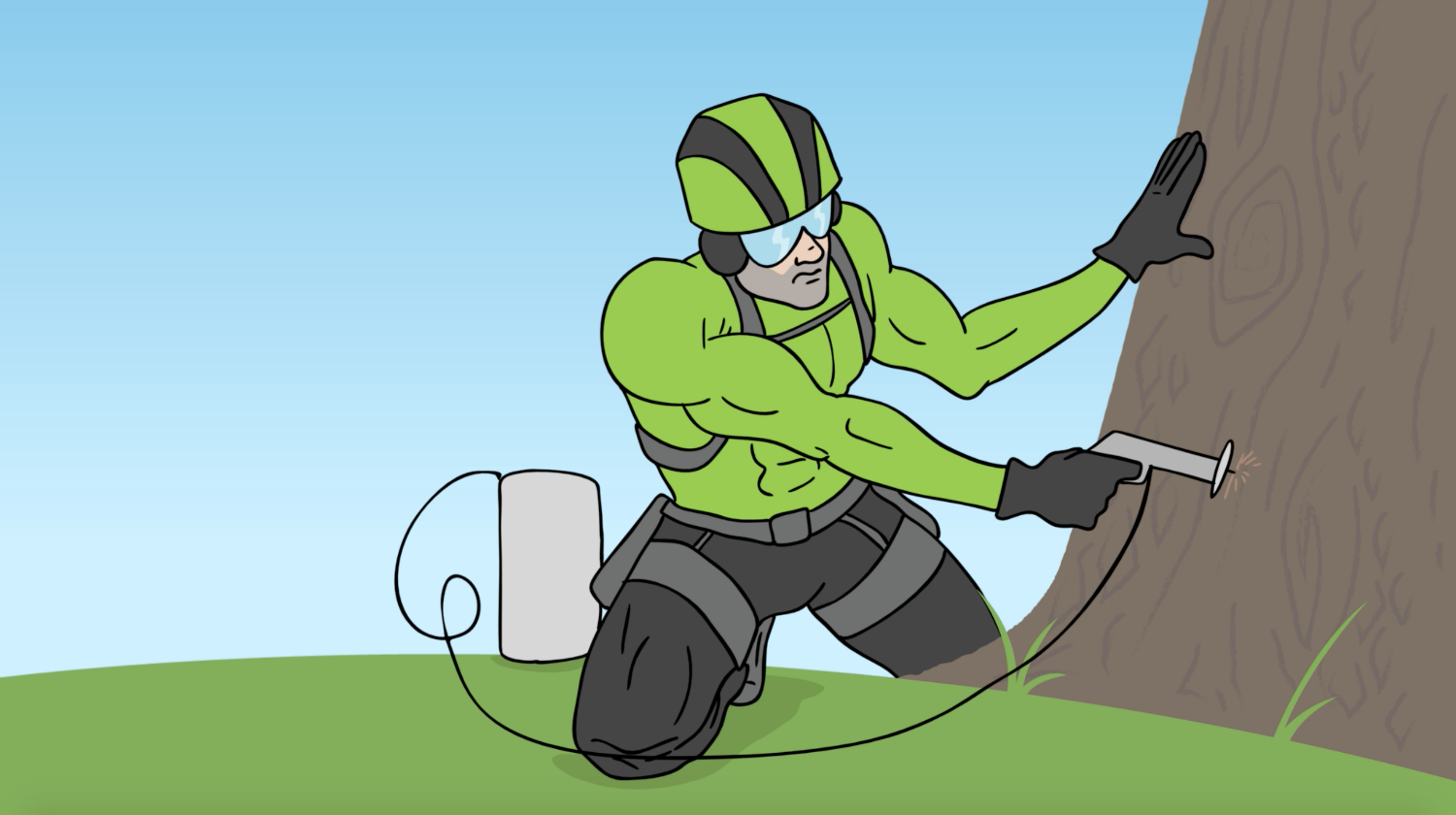
Emerald Ash Borer Treatment Option: Trunk Injection
Smart Ash’s Note: If it’s detailed information about emerald ash borer trunk injection treatments you want, you’ve come to the right place. If you want higher-level, more actionable information about your options as an ash tree owner, visit our emerald ash borer treatment options page.
Several systemic insecticide products can be injected directly into the trunk of the ash tree including formulations of azadirachtin, emamectin benzoate, and imidacloprid. An advantage of trunk injections is that they can be used on sites where soil treatments may not be practical, effective or appropriate, including trees growing on excessively wet, sandy, compacted or restricted soil environments.
Trunk injections generally involve drilling through the bark and into the outer sapwood at the base of the ash tree. Drilling wounds could cause long-term damage, especially if treatments are applied annually. However, recent studies of emamectin benzoate (TREE-äge™) injected with Arborjet equipment and imidacloprid (Imicide®) injected with Mauget capsules in May showed ash trees rapidly recovered and began producing new wood over the wounds in late summer. Products applied as trunk injections are typically absorbed and transported within the tree more quickly than soil drench applications.
Emamectin benzoate: In several intensive studies conducted by Michigan State University and Ohio State University (OSU) researchers, a single injection of emamectin benzoate (TREE-äge™) in mid-May or early June provided excellent control of EAB for at least two years, even when EAB densities were high. Depending on application rate and pest pressure, treatment with emamectin benzoate may even protect trees for three years. Moreover, in side-by-side comparisons, emamectin benzoate was more effective than other EAB treatment products.
Azadirachtin: Results from a two-year study in Michigan showed azadirachtin products like TreeAzin affect EAB differently than other insecticide products. Unlike other insecticide products, specifically emamectin benzoate (trunk injection) or dinotefuran (basal trunk spray), leaves from trees treated with azadirachtin were not acutely toxic to adult EAB. However, azadirachtin reduced the ability of mature female EAB to produce viable eggs that successfully hatched. When the trees in this study were felled and debarked after two years of exposure to EAB, it was apparent that numerous EAB larvae had begun feeding on trees treated with TreeAzin but died while still young and small. Results from this study suggest that in most years, TreeAzin will effectively protect ash trees for two years, but when EAB densities are high, annual applications may be prudent.
Imidacloprid: Trunk injections with imidacloprid products have provided varying degrees of EAB control in trials conducted at different sites in Ohio and Michigan. In an OSU study in Toledo, IMA-jet® provided excellent control of EAB on 15- to 25-inch trees under high pest pressure when trees were injected annually. However, trees that were injected every-other-year were not consistently protected. In one Michigan study, ash trees continued to decline from one year to the next despite being injected in both years with either Bidrin (Inject-A-Cide B®) or imidacloprid. All three treatment regimens suppressed EAB infestation levels in both years, with Imicide® generally providing best control under high pest pressure in both small (six-inch diameter at breast height, or DBH) and larger (16-inch DBH) caliper trees. However, larval density increased in treated and untreated trees from one year to the next, and even consecutive years of these treatments only slowed ash decline under severe pest pressure.
EAB trunk injection application methods that rely on high pressure injections of insecticide through needles inserted into small holes may damage the tree if the pressure causes the bark to bulge and separate from the cambium. This is most likely to occur in spring and can cause larger wounds that result from death of the vascular tissue at the point of separation.
Allow at least two and preferably three to four weeks for most trunk-injected products to move through the tree. Optimal timing of trunk injections occurs after trees have leafed out in spring but before EAB eggs have hatched, or generally between mid-May and mid-June. Uptake of trunk-injected insecticides will be most efficient when trees are actively transpiring. Best results are usually obtained by injecting trees in the morning when soil is moist but not saturated. Uptake will be slowed by hot afternoon temperatures and dry soil conditions. Irrigating trees during drought conditions will help with insecticide uptake and translocation within the tree.
This information was adapted from a multi-state study on emerald ash borer insecticides performed by Colorado State, Ohio State, Michigan State and Purdue universities. So, which EAB treatment method is the best for ash trees in Metro Denver, an area that includes 1.45 million ash trees? Unfortunately, there isn’t one right answer.
The best treatment for your Denver ash depends on a variety of factors, and is ultimately dependent on property owner preference. While some experts might not recommend treating your ash tree before EAB is found in Denver, it is worth noting that it may take three years for your tree to show obvious signs of infestation. And by then, it may be too late to save. Before making any decisions, you should consult multiple sources. This list of Certified Smart Ashes, all of whom are licensed by the Colorado Department of Agriculture to apply pesticides, is a great place to start.
